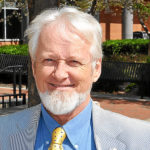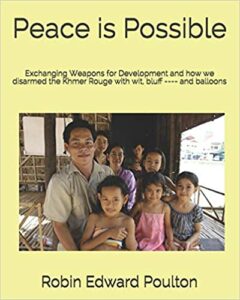Peace Proved to Be Possible, Even after Thirty Years of Cambodian Civil War
REVIEWS, 16 Nov 2020
Robin Edward Poulton, Ph.D. – TRANSCEND Media Service
As proponents of Peace Journalism in a world of wars and conflicts, a conflict resolution and disarmament success story is a precious commodity. Cambodia at the turn of the Millennium provided such a story.
Context
A quick reminder: Cambodia fell to pieces after – and as a direct result of – the Vietnam War. Vietnam and Cambodia were both French colonies. When the French were forced to leave Vietnam after their military defeat in Dien Ben Phu, the American army moved in to fill the war space. Next-door Cambodia found life difficult between the Yanks and the Viets. The wily Khmer leader King Sihanouk was not strong enough to deny either power, allowing the Americans to use his seaports, while tolerating Vietnamese transport of goods using paths on the Khmer side of the frontier (the Ho Chi Minh Trail). The Americans wanted subservience, and in 1970 the CIA supported their stool pigeon General Lon Nol – serving as Sihanouk’s prime minister – to seize power, abolish the monarchy and declare a Khmer Republic under his dictatorship. This American mis-calculation turned the whole Cambodian people against them overnight. The King was an admired, almost god-like figure. Lon Nol’s regime was totally corrupt, and totally dependent on the Americans whose money fed the corruption.
The Lon Nol coup transformed the Khmer Rouge, a minor communist guerrilla force led by Pol Pot in the northern borderlands, into the official armed opposition and the country was now in open civil war. Sihanouk had no choice but to seek Chinese support ….. which later transformed the King into a prisoner of the Khmer Rouge. When the Americans fled Vietnam in 1975, Lon Nol fled too and the country they had destroyed together was set for a Communist take-over. The story of Pol Pot’s regime is well-known: a million people died until Khmer Rouge deserters led a Vietnamese army to clear out Pol Pot and restore sanity. One of those leaders was Hun Sen, who is still Cambodia’s Prime Minister. Sihanouk having died, Cambodia today is led by his successor King Norodom Sihamoni. Prime Minister Hun Sen, the real political power broker, has ruled Cambodia for almost 30 years.
Peace Is Possible
If you want a fascinating story that you could never have imagined, this short book is for you! What is “Peace”? Most of us have no idea what “peace” actually means. After 30 years of civil war, torture and the Pol Pot genocide, what could “Peace” possibly mean to Cambodian villagers? For a start, it means fewer firearms.
This book tells a wonderful story of how Khmer Rouge villagers were persuaded to define peace for themselves. Poulton was engaged in a Council of Europe security sector reform project led by his friend and mentor General Henny van der Graaf. For Henny, this was politics and military reform; for Robin it was peace anthropology. Without deep knowledge Cambodia, he learned as he advanced, reading densely and watching intently. Crawling across the wooden floors of rural pagodas behind the local governor, he counted the number of times he should bow to golden statues of the Buddha, then to the saffron-colored monks. He charmed the monks to become his disarmament allies. He used humour to convince Cambodian villagers to give up their Kalashnikovs and accept development projects in exchange for their rifles. Exchanging Weapons-for-Development: it sounds obvious, but it only happens with good NGO support. Who imagines how “Peace” is actually created? Poulton explains how it can was done along the Ho Chi Minh Trail, telling a great story with some wonderful pictures of Cambodia and its post-war chaos.
You can read this story in an hour. To understand it may take you a lifetime. For United Nations peace experts, there are Lessons Learned and checklists to help them transfer the Cambodian experience to (say) Syria or Libya or Yemen …… but for anyone interested in Asian culture, for anyone interested in the processes of peace, this story is a fascinating, eye-opening revelation.
Peace Is Possible: Exchanging Weapons for Development and How We Disarmed the Khmer Rouge with Wit, Bluff and Balloons, Robin Edward Poulton (author), David de Beer (preface), 19 April 2020, Kindle books, Amazon
__________________________________
 Robin Edward Poulton, Ph.D. is a member of the TRANSCEND Network for Peace, Development and Environment and an independent researcher associated with UNIDIR-UN Institute for Disarmament Research and with the education association Virginia Friends of Mali. Poulton is the founder of the EPES Mandala Peace Consultancy. He is a sometime faculty member of the European Peace University (Austria), an Affiliate Research Professor at Virginia Commonwealth University, and a consultant advisor on Africa to governments, the U.N. and the European Union. Poulton is a specialist in terrorism, disarmament, conflict transformation and peace building having 25 years of field experience with UNDP, EU, USAID and NGOs. He is the author of several books in French and English on development and disarmament. He received his Ph.D. from the Ecole des Hautes Etudes en Sciences Sociales in Paris, France. repoulton@epesmandala.com
Robin Edward Poulton, Ph.D. is a member of the TRANSCEND Network for Peace, Development and Environment and an independent researcher associated with UNIDIR-UN Institute for Disarmament Research and with the education association Virginia Friends of Mali. Poulton is the founder of the EPES Mandala Peace Consultancy. He is a sometime faculty member of the European Peace University (Austria), an Affiliate Research Professor at Virginia Commonwealth University, and a consultant advisor on Africa to governments, the U.N. and the European Union. Poulton is a specialist in terrorism, disarmament, conflict transformation and peace building having 25 years of field experience with UNDP, EU, USAID and NGOs. He is the author of several books in French and English on development and disarmament. He received his Ph.D. from the Ecole des Hautes Etudes en Sciences Sociales in Paris, France. repoulton@epesmandala.com
Tags: Cambodia, Conflict Analysis, Conflict Resolution, Education for Peace, Literature, Reviews, Violent conflict
This article originally appeared on Transcend Media Service (TMS) on 16 Nov 2020.
Anticopyright: Editorials and articles originated on TMS may be freely reprinted, disseminated, translated and used as background material, provided an acknowledgement and link to the source, TMS: Peace Proved to Be Possible, Even after Thirty Years of Cambodian Civil War, is included. Thank you.
If you enjoyed this article, please donate to TMS to join the growing list of TMS Supporters.

This work is licensed under a CC BY-NC 4.0 License.
